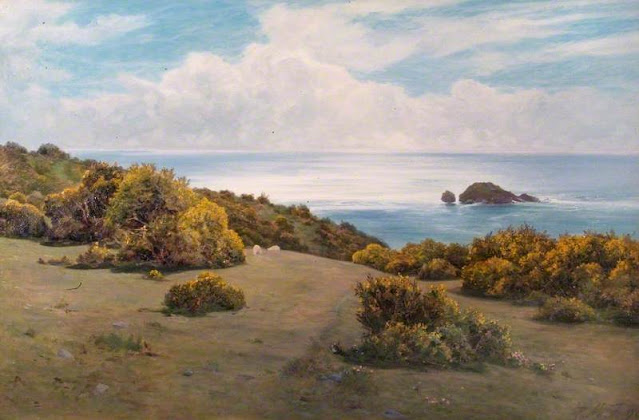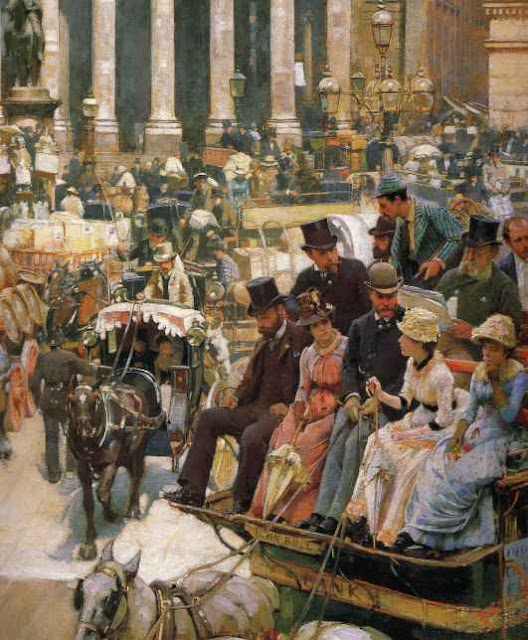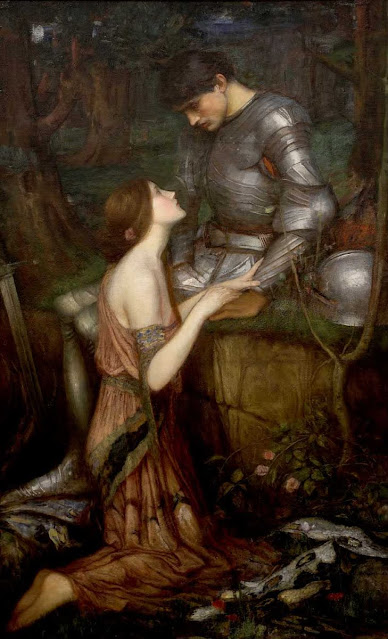My current obsession is the spouses of artists who were also artists. I do not get out very much but bear with me as that is a very interesting dynamic and makes me wonder how rubbishly history treats female artists. Of late, I have done a few posts of artists who married artists and there are certainly some well-known couples in the Victorian/Pre-Raphaelite field, however today's subject/victim is a bit different. You might not have heard of her, you will definitely have heard of her husband and you will be surprised how well you know her face. Say hello to Esther Maria Kenworthy Waterhouse...
 |
| The Lady of Shalott (1888) John William Waterhouse |
Okay, we shall get on to how this is Esther and why I'm dubious but why I think Esther is massively important in the art of her husband John William Waterhouse, but first let's cover Esther's alarmingly tragic backstory...
Esther was born in October of 1857 to James Lees Kenworthy and his with Elizabeth Caroline Atlee. Elizabeth's father had been a teacher at the Grove School in Ealing and James Kenworthy was a teacher of perspective and painting at Kerrison Lodge which functioned as both a boarding school and home to the Kenworthy family. It is also written he was an artist too, but I can't find any evidence of his work (but it was often the case that art teachers were also artists in a professional sense). He was, however, a member of the Royal Astronomical Society and the National Temperance League, so both educated and sober, which is a jolly combination. The Kenworthys had married in 1850 and between 1852 and 1870 produced around 10 children, with Esther appearing somewhere in the midst. James didn't last much longer, dying in 1876, leaving the family with very little in the way of money (probate was under £300). The family remained at Kerrison Lodge, with Elizabeth listing herself as a school teacher by the 1881 census.
Right, I hope you are braced as it gets a bit bumpy now. Esther had two brothers, Edward Augustus Sidney (known as Sidney) and Nelson, who wished to go to sea to seek their fortune and careers. They were off to New Zealand aboard the Avalanche, a sailing ship, which was also full of people from New Zealand, sailing home to Wanganui, including the daughter of the mayor. At 9.30pm on the 11th September 1877, it was struck amidships by the Forest, a Nova Scotia vessel, and sank in less than three minutes, drowning all but three people on board. The Forest sank slower and so most of the passengers and crew scrambled into lifeboats and were rescued by fishermen. The sizable loss of life, especially with the toll felt on both sides of the hemisphere, made national and international news, but the death of the two brothers, off to their new life in New Zealand must have been keenly felt by the family.
Next came the death of eldest sister Elizabeth's husband, George Willcocks. The couple had only married in 1878, but he died in 1882. They were still living with his parents in the 1881 census so I'm not sure how much of a married, independent life they got before George popped off. Not put off by this, Elizabeth remarried in 1886 to Edward Sandford and he managed to last until 1909.
Lastly, the eldest brother Charles James Fox Kenworthy died in 1887 of diphtheria. He had been an accountant and a beekeeper. One of his mother's relatives, Charles Atlee had been instrumental in the formation of the British Bee-Keeper's Association and according to his obituary in the British Bee Journal, his father James had been a keen beekeeper too. In 1887 there was an outbreak of diphtheria in Ealing that baffled the authorities for a while as it was only the wealthier households that were affected. There were 23 cases and 3 deaths including Charles. The source of the outbreak was tracked back to a dairy, hence the households who could afford milk and dairy products being the ones who suffered. The case was covered in the Lancet and in the national news. It's not that the Kenworthy family were unusually blessed with bad luck, it's just the manner in which it struck was newsworthy. Anyway, in the midst of all that was Esther, who was training to be an artist...
 |
| Esther (c.1885) Antonio Sorgato, Venice |
Not much is recorded of Esther's training, but in the 1881 census, she is listed as living at home and working as an artist. In the 1882 Directory of Artists, Miss E Kenworthy is listed, together with the acknowledgment that she had one painting at the Royal Academy exhibition of that year, a watercolour of Wallflowers. The Aberdeen Press and Journal referred to it as "an effective study" in their review of that year's show. It might have been at the Royal Academy school that Esther met her future husband, John William Waterhouse, or maybe at the exhibition but in 1883 the couple married. There are some sizable and impressive tomes written on Waterhouse which I won't plunge into here, but I was impressed with the effort he went into for his tragic backstory. Born in Rome, John 'Nino' Waterhouse was moved to Kensington as a little child, where his mother and two brothers died of tuberculosis. Marvellous.
 |
| Portrait of the Artist's Wife (c.1885) John WIlliam Waterhouse |
After marriage at St Mary's Church in Ealing, Mr and Mrs Waterhouse moved to Primrose Hill to establish their studios, first at number 3, then number 6. They were soon surrounded by fellow artists and friends, including one of Esther's brother-in-laws, the artist Peregrine Malvogue Feeney, a landscape painter from Birmingham who married Emily Kenworthy in 1891.
 |
| Baggy Point, Devon (undated) P M Feeney |
Their neighbours included this motley lot...
This photo is from the magnificent 2008 catalogue from the Royal Academy exhibition and shows Esther standing at the back with an umbrella, Emily her sister looking dubious, sitting on the left, another sister Edith being handed something by Waterhouse, wearing a turban. This was a fancy dress party from around 1884-88, and in addition to this, the Waterhouses socialised with other artists including Antwerp-trained William Logdail, who painted the couple multiple times (there is a helpful post on him here).
 |
| Primrose Hill School (1893) Unknown artist |
This caricature of the gang form the 1890s, shows Waterhouse in the middle in a tutu and mary-janes for some reason, but Esther is at the bottom with her back to us, her striped belt tied in a bow. She is very much in the mix with the other artists, even though by this point we don't have any paintings listed by her. The couple were obviously good friends with the other artists. Logsdail painted this famous portrait of Waterhouse...
 |
| John William Waterhouse (c.1887) William Logsdail |
But more interestingly, he painted this picture of Esther...
 |
| Portrait of Esther Kenworthy Waterhouse in the Artist's Studio (1880s) William Logsdail |
In the lot essay that accompanied the sale of this painting, Logsdail recalled the happy family nature of Primrose Hill, how the artists were in and out of each other's studios as seen here with Esther. Is she in Logsdail's studio or her own? Interestingly, Logsdail had written 'Manet' in the lower right corner - was he referring to Edouard Manet's images of female artists, such as Eva Gonzales and Berthe Morisot?
 |
| Rest (Berthe Morisot) (1870) Edouard Manet |
Both Mr and Mrs Waterhouse appeared in other of Logsdail's works, most notably in the extremely busy The Bank and the Royal Exchange from 1887...
 |
| It's like an artistic version of Where's Wally? |
 |
| There they are - I'm guessing they are the couple on the left with possibly Emily and Edith as the other two women |
Anyway, I wanted to bring you much news and pictures by Esther, but do you know what? Nothing. She did more flower paintings, exhibiting Azaleas in 1885, Pink Roses in 1887, Violets in 1888 and Carnations and Violets in 1889, then nothing and we have no images for any of these. If you have any of these or even just images, please give me a shout as I'd love to see them. If she painted beyond this, we cannot say at present as her artistic presence drops off the radar. However, in 1888, she did, allegedly pose for The Lady of Shalott. Now, I'm not being critical, and to be honest, all Waterhouse women sort of look the same, however I can't see a great likeness between John William Waterhouse's portrait of her from 1885 and the Lady in 1888 but the style, setting and intention are completely different. An equivalence would be the painting of Ethel Warwick in her coat and hat and one of the draped figures both by John William Godward. However, I am wondering whether Esther posed for any of the following which honestly look more like her...
 |
| Cleopatra (1888) John William Waterhouse |
 |
| The Magic Circle (1886) John William Waterhouse |
 |
| Head of a Woman (1883-4) John William Waterhouse |
I would argue that the strong-featured women that pre-date The Lady of Shalott all resemble Esther and that Cleopatra resembles Esther more than The Lady of Shalott does, but then after a while all of Waterhouse's women looked alike. Like Rossetti, he had a type. Anyway, I don't think that is the only thing that Esther brought to Waterhouse's paintings. If we consider that Esther was a specialist flower painter, then what do we make of things like this...?
 |
| Gather Ye Rosebuds While Ye May (1908) John William Waterhouse |
 |
| The Soul of the Rose (1903) John William Waterhouse |
 |
| Lamia (1905) John William Waterhouse |


Thanks for another great post, Kirsty. I hope someone out there has copies of her work. I wonder if she stopped painting altogether once she was married? Once married, women were supposed to look after the family and devote themselves to running the household - like Georgie Burne-Jones did. A few lucky ones continued, but they seem to be in the minority. There must be countless women artists who were forgotten for just that reason.
ReplyDeleteBest wishes
Ellie
Read this in 2025 on a deep dive to see if I could find her work. Did you ever come across any?
ReplyDeleteNot yet, but have since been contacted by other intrepid researchers, so fingers crossed more will come to light soon!
Delete